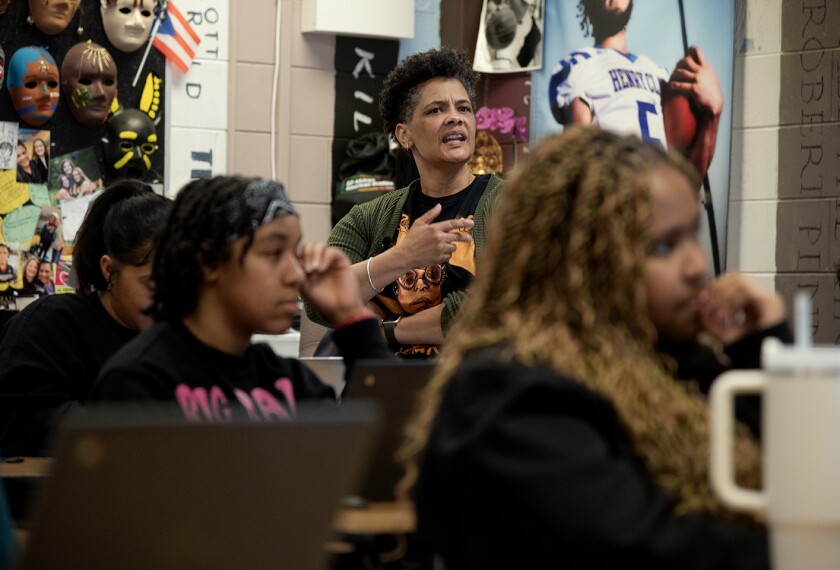None of the most widely used middle school science textbooks is adequate to teach students fundamental concepts, a study released last week concludes.
| George D. Nelson shares the results of Project 2061’s middle school textbook analysis at a press conference last week. --Benjamin Tice Smith |
The review of nine textbooks was conducted by Project 2061, the education improvement initiative of the American Association for the Advancement of Science, and underwritten by the Carnegie Corporation of New York.
“This is basically the national curriculum for middle school science,” George D. Nelson, the director of Project 2061, said in releasing the results here. “It’s a credit to science teachers that their students are learning anything at all.”
In buying science textbooks, he said, districts must “make the best of a sad set of choices.”
The textbooks studied--including popular books by the publishers Glencoe/McGraw-Hill and Prentice-Hall--fell short on many counts, according to the study.
Reviewers concluded that they covered too many subjects with little depth, didn’t develop key ideas well, and included classroom activities that were either irrelevant or failed to help students relate what they were doing to underlying scientific concepts.
The study examined how well textbooks can help students learn central ideas in earth science, life science, and physical science. Those concepts were drawn from the AAAS’s Benchmarks for Science Literacy, a set of learning goals for various grade levels created by Project 2061, and the National Research Council’s National Science Education Standards.
‘Instructional Analysis’
Specifically, the reviewers focused on instruction in the processes that shape the earth, the transformation and transfer of matter and energy, and kinetic-molecular theory.
“Science is not a pile of facts,” Mr. Nelson said. “It’s built on a foundation of core knowledge, and that’s what we want students to learn at this level.”
For the study, teams of evaluators made up of middle school teachers, curriculum specialists, and professors of science education conducted an “instructional analysis” to determine whether the textbooks would educate students on the topics.
To get high marks, a textbook had to take into account students’ own ideas about science, including commonly held notions that are often wrong.
The books also were expected to give students a sense of purpose for learning a lesson, engage students with relevant scientific phenomena, help them conceive and use scientific ideas and terms, encourage students to examine their own ideas and to reason, and provide teachers with assessments of students’ learning to inform their instruction.
On a 3-point scale, with 3 representing a satisfactory text, the nine books reviewed earned poor marks--all below a 1.5. The textbooks did the best job with physical science, the reviewers found.
The reviewers also examined a teaching unit called “Matter and Molecules” developed in 1988 by researchers at Michigan State University. It alone won a satisfactory rating and provides evidence that it is possible to write far better textbooks, said Jo Ellen Roseman, the curriculum director for Project 2061. “This is not beyond our capacity,” she said. “We simply have to have the will.”
The teachers’ guide to “Matter and Molecules,” for example, contains a detailed paragraph explaining why students have difficulty understanding that molecules are constantly moving.
In contrast, the study found, a few textbooks have notes for teachers on students’ misconceptions or prior knowledge. But those that did provided little information--just one sentence--to alert teachers to problems. For example, Science Insights: Exploring Matter and Energy, by Addison-Wesley, says simply that “students may identify matter as only things they can see.”
Listening to Students
Charles W. Anderson, a professor of teacher education at Michigan State who worked on the unit, said faculty members spent time talking to students as part of the process. After finding out how the youngsters approached particular topics, the researchers designed instructional approaches that helped middle schoolers understand scientific theories.
“We were asking sensible questions to kids, listening, and then saying, ‘If that’s what they think, what do we have to do to help them understand scientific ideas?’ ” Mr. Anderson explained.
But in the commercial world of textbooks, he said, students aren’t consulted, and their understanding isn’t paramount in determining what goes into a book.
The textbook industry is driven by the demands of states, especially California and Texas, that adopt lists of books that can be purchased with state money. Typically, such states provide detailed requirements to publishers on topics and facts to be included.
“They are the decisionmakers who establish the curriculum and select the instructional materials that best address the needs of their students,” Pat Schroeder, the president and chief executive officer of the Washington-based Association of American Publishers, said in a statement.
Acknowledging that the publishing industry is responding to market forces, Mr. Nelson called on governors and chief state school officers to “demand better materials.”
Project 2061 hopes that university faculty members will use its findings to conduct more research on student learning that can be fed into textbooks, he added.
The National Science Foundation is trying to stimulate the production of better teaching materials with a request for proposals that follows Project 2061’s guidelines.
The review of science textbooks is the second in a series. In January, Project 2061 released the results of a study of middle school mathematics texts that found four satisfactory books. (“Reviews of Math Text Parallel Pedagogy Rifts,” Jan. 27, 1999.)
Project 2061 is “trying to tweak the market in the same way Consumer Reports does,” Mr. Anderson said, “by creating niches in the market that are based on different criteria.”




